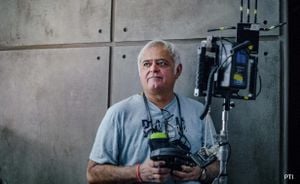China's Chang'e-6 mission has revealed astonishing new insights about the lunar surface, especially after it successfully returned samples from the moon's far side, particularly from the South Pole-Aitken Basin (SPA). The mission offers exquisite glimpses at volcanic activity on the moon and suggests the presence of ancient basalt rock, dating back 2.83 billion years.
The moon's surface has long intrigued scientists due to its unique global dichotomy. The near side is vastly different from the far side, particularly when it concerns features like geomorphology, topography, and volcanic activity. While the near side is peppered with dark basalt plains, the far side appears more rugged and is less volcanic. This stark difference has led researchers to gather samples to understand why these variations exist.
Recently, Professor Xu Yigang's team from the Guangzhou Institute of Geochemistry at the Chinese Academy of Sciences undertook the ambitious task of analyzing these lunar samples. Their findings add depth to the current lunar narrative, providing what they termed the “best opportunity to investigate the lunar global dichotomy.” This investigation was detailed in their paper published on November 15, 2024, in _Science_.
Within the Chang'e-6 lunar soil samples, researchers identified two key types of mare basalts: low-Ti basalt and very low-Ti (VLT) basalt. The low-Ti basalt appears to be native to the area where Chang'e-6 landed, whereas the VLT basalt likely originates from the nearby geologic formations. This differentiation sheds light on the local geology and volcanic history.
Analysis techniques included high-precision dating methods for zircon-bearing minerals and rubidium-strontium dating of other minerals, yielding consistent isochron ages of approximately 2.83 billion years. Such findings indicate not only the moon's geological activity but also challenge the notion of only ancient volcanism being prevalent on the far side, as it points to ‘young magmatism’—volcanic activity occurring more recently than previously thought.
When comparing the newly analyzed low-Ti basalt from Chang'e-6 with samples from the near side, such as those collected by the Apollo and Chang'e-5 missions, notable differences emerge. The low-Ti basalt from Chang'e-6 displayed lower µ values and 87Sr/86Sr ratios, alongside significantly higher εNd values. This data suggests the basalt has roots from a particularly depleted mantle source, prompting researchers to rethink current theories about the source of the moon's volcanism.
The aspect of crustal thickness has traditionally been viewed as key to explaining the discrepancy between volcanic activity on the moon’s two hemispheres. It was once thought the far side, with its thinner crust, should experience more volcanic activity, yet the findings from Chang'e-6, particularly within the SPA, challenge this traditional view. Instead, the research proposes the mantle composition plays a pivotal role, as the depleted and refractory nature of the material beneath the SPA seems to prevent significant melting necessary for volcanism.
These insights pave the way for advancements not only in lunar geology but also hold potential for revising lunar impact chronology. The new findings allow for the calibration of lunar crater aging models, providing clearer timelines for other celestial bodies as well, and hint at impacts associated with planetary migration during the early solar system.
At the recent 15th China International Aviation and Aerospace Exhibition, the Chang'e-6 samples garnered much attention, with visitors excited to see the pieces of moon rock firsthand. The exhibit accentuates the growing public and scientific interest surrounding China's lunar exploration efforts and highlights the broader intrigue surrounding lunar studies.
Beyond showcasing the lunar samples and their storied history, the advancements made from the Chang'e-6 mission represent significant strides for China’s space endeavors. The successful mission has drawn public interest, inspiring discussions about the future of lunar exploration and what mysteries the moon holds for scientists trying to piece together the solar system's past.
The Chang'e-6 samples not only contribute to our current science narratives but also encapsulate the adventure of human exploration beyond Earth. With each new finding, the story of our moon—and perhaps our solar system—grows richer.



